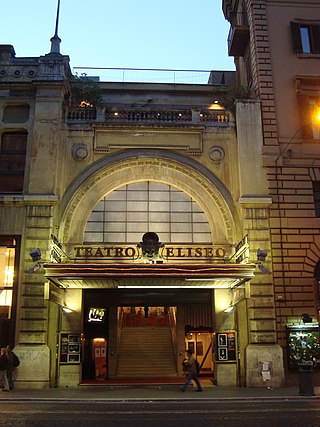
Eduardo De FilippoOMRI, also known simply as Eduardo, was an Italian actor, director, screenwriter and playwright, best known for his Neapolitan works Filumena Marturano and Napoli Milionaria. Considered one of the most important Italian artists of the 20th century, De Filippo was the author of many theatrical dramas staged and directed by himself first and later awarded and played outside Italy. For his artistic merits and contributions to Italian culture, he was named senatore a vita by the President of the Italian Republic Sandro Pertini.

Cinecittà Studios is a large film studio in Rome, Italy. With an area of 400,000 square metres, it is the largest film studio in Europe, and is considered the hub of Italian cinema. The studios were constructed during the Fascist era as part of a plan to revive the Italian film industry.

The Teatro dell'Opera di Roma is an opera house in Rome, Italy. Originally opened in November 1880 as the 2,212 seat Costanzi Theatre, it has undergone several changes of name as well modifications and improvements. The present house seats 1,560.

The Accademia Nazionale di Santa Cecilia is one of the oldest musical institutions in the world, founded by the papal bull Ratione congruit, issued by Sixtus V in 1585, which invoked two saints prominent in Western musical history: Gregory the Great, for whom the Gregorian chant is named, and Saint Cecilia, the patron saint of music. Since 2005 it has been headquartered at the Renzo Piano designed Parco della Musica in Rome.

The Teatro Argentina is an opera house and theatre located in Largo di Torre Argentina, a square in Rome, Italy. One of the oldest theatres in Rome, it was constructed in 1731 and inaugurated on 31 January 1732 with Berenice by Domenico Sarro. It is built over part of the curia section of the Theatre of Pompey. This curia was the location of the assassination of Julius Caesar.

The Teatro Quirino is an opera house in Rome opened in 1871. It hosted the premiere of Pietro Mascagni's operetta Sì.

Parco della Musica is a public music complex in Rome, Italy, with three concert halls and an outdoor theater in a park setting. It was designed by Italian architect Renzo Piano. Jürgen Reinhold of Müller-BBM was in charge of acoustics for the halls; Franco Zagari was landscape architect for the outdoor spaces. Parco della Musica lies with the Foro Italico in the north area of Rome's ancient center, and is home to most of the facilities of the Accademia Nazionale di Santa Cecilia.

Anton Giulio Bragaglia was a pioneer in Italian Futurist photography and Futurist cinema. A versatile and intellectual artist with wide interests, he wrote about film, theatre, and dance.

Rivoli Theatre is a municipal theatre in Porto, Portugal.

The Teatro Petruzzelli is the largest theatre of the city of Bari and the fourth Italian theatre by size.
The Claretianum, officially the Claretian Pontifical Institute of the Theology of the Consecrated Life, is an educational institute of the Roman Catholic Church in Rome founded by the Claretians. It is part of the Pontifical Lateran University as an institute specialising in the theology of the consecrated life.

Regina Bianchi was an Italian stage and film actress.

The Teatro Capranica is a theatre situated at 101 Piazza Capranica in the Colonna district of Rome. Originally constructed in 1679 by the Capranica family and housed in the early Renaissance Palazzo Capranica, it was the second public theatre to open in Rome. It was the site of many premieres of Baroque operas including Caldara's Tito e Berenice, Scarlatti's Griselda, and Vivaldi's Ercole su'l Termodonte. The Capranica ceased operating as a full-scale theatre and opera house in 1881 and in 1922 was converted into a cinema. Following the closure of the cinema in 2000, it has functioned on a hire basis as a conference and performance venue.

The Teatro Eliseo is a theatre located in Rome, Italy.

The Teatro Ambra Jovinelli, formerly known just as Teatro Jovinelli, is a theatre located in Rome, Italy.

The Teatro Adriano, also known as Politeama Adriano and Cinema Adriano, is a cinema and former theatre located in Piazza Cavour, Rome, Italy.

Raimonda Gaetani is an Italian stage set and costume designer.
The Teatro Contavalli was an opera house and theatre located at Via Mentana #2, in Bologna, region of Emilia-Romagna, Italy. Long since utilized as a theater, the site is now occupied by offices for the Centro Italiano di Documentazione sulla Cooperazione e L' Economia Sociale.

The Teatro Sá da Bandeira is the oldest performance venue in the city of Porto, with a capacity for 786 people and opened in 1846, it was responsible for the first presentation of films produced in Portuguese, and was converted in the first years of its opening on stage to some of the 19th century theater biggest stars, such as Sarah Bernhardt, Julián Gayarre and Antonio Scalvini.

















